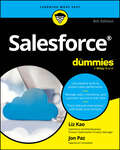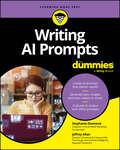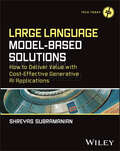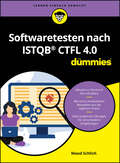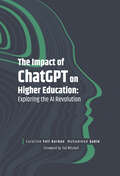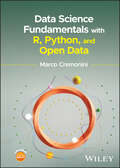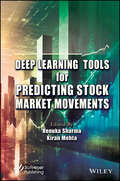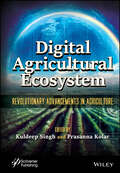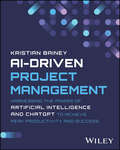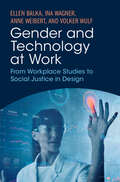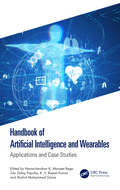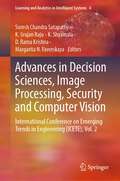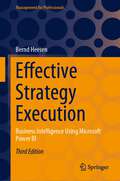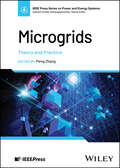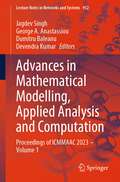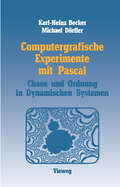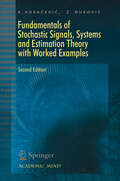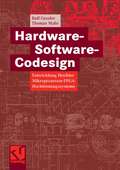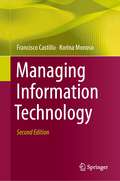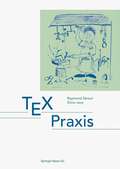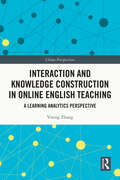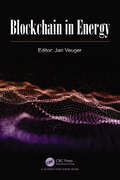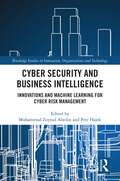- Table View
- List View
Salesforce For Dummies
by Liz Kao Jon PazYour easy-to-follow guide to the world’s leading cloud-based CRM software Salesforce gives your business an edge in tracking relationships and managing sales, marketing, customer service, and support operations. Salesforce For Dummies help you take advantage of key platform functionality and focus on making the most of its many features. Learn best practices to determine the right configuration to suit your business needs, and how to use apps, build widgets, and configure features to personalize your system for your business. Explore prospecting for leads, managing accounts, maintaining contacts, tracking products, calculating forecasts, and monitoring each customer’s service and support interactions with your business. Collaborate with colleagues by sharing information across a 360-degree view of all customer interactions, enhance your online marketing, gain real-time visibility into sales, and close deals faster. Get started with configuring Salesforce and set up the apps that your business needs Discover the latest updates to Salesforce, including Flow Builder, Lightning, and Einstein Improve business performance with reporting insights, collaborative communication features, and integrated sales and marketing processes Find new ways to improve productivity and reduce administration timeSalesforce For Dummies is the fully updated, best-selling guide that helps new and existing users get up to speed with the world’s top CRM.
Writing AI Prompts For Dummies
by Stephanie Diamond Jeffrey AllanLearn the art of writing effective AI prompts and break into an exciting new career field Unlock the full power of generative AI with Writing AI Prompts For Dummies, a comprehensive guide that will teach you how to confidentially write effective AI prompts. Whether it's text, images, or even videos and music you're aiming to create, this book provides the foundational knowledge and practical strategies needed to produce impressive results. Embark on a journey of discovery with Writing AI Prompts For Dummies and learn how to: Craft AI prompts that produce the most powerful results. Navigate the complexities of different AI platforms with ease. Generate a diverse range of content, from compelling narratives to stunning visuals. Refine AI-generated output to perfection and integrate that output effectively into your business or project. This resource is brimming with expert guidance and will help you write AI prompts that achieve your objectives. Whether you're a marketer, educator, artist, or entrepreneur, Writing AI Prompts For Dummies is your indispensable guide for leveraging AI to its fullest potential. Get ready to harness the power of artificial intelligence and spark a revolution in your creative and professional efforts.
Large Language Model-Based Solutions: How to Deliver Value with Cost-Effective Generative AI Applications (Tech Today)
by Shreyas SubramanianLearn to build cost-effective apps using Large Language Models In Large Language Model-Based Solutions: How to Deliver Value with Cost-Effective Generative AI Applications, Principal Data Scientist at Amazon Web Services, Shreyas Subramanian, delivers a practical guide for developers and data scientists who wish to build and deploy cost-effective large language model (LLM)-based solutions. In the book, you'll find coverage of a wide range of key topics, including how to select a model, pre- and post-processing of data, prompt engineering, and instruction fine tuning. The author sheds light on techniques for optimizing inference, like model quantization and pruning, as well as different and affordable architectures for typical generative AI (GenAI) applications, including search systems, agent assists, and autonomous agents. You'll also find: Effective strategies to address the challenge of the high computational cost associated with LLMs Assistance with the complexities of building and deploying affordable generative AI apps, including tuning and inference techniques Selection criteria for choosing a model, with particular consideration given to compact, nimble, and domain-specific models Perfect for developers and data scientists interested in deploying foundational models, or business leaders planning to scale out their use of GenAI, Large Language Model-Based Solutions will also benefit project leaders and managers, technical support staff, and administrators with an interest or stake in the subject.
Softwaretesten nach ISTQB CTFL 4.0 für Dummies (Für Dummies)
by Maud SchlichNeue Hauptversion 4.0: Neuer Lehrplan, geänderter Prüfungsumfang! Soll in Ihrem Unternehmen neue Software eingeführt werden und Sie müssen sie testen? Oder wollen Sie als Entwickler über den Tellerrand schauen und sich auch mit dem Softwaretesten beschäftigen? Leicht verständlich erläutert Ihnen Maud Schlich alle vom ISTQB® Certified Tester Foundation Level geforderten Lerninhalte sowohl für Programmierer als auch mit Blick auf Fachanwender, die die Software später einsetzen. Zahlreiche praxisorientierte Beispiele und übungen sorgen für eine optimale Prüfungsvorbereitung. Darüber hinaus erfahren Sie für alle Testaktivitäten, wie sie jeweils im klassischen oder im agilen Kontext geplant und durchgeführt werden. Sie erfahren Aus welchen Aktivitäten der Testprozess besteht Wie Sie unterschiedliche Testverfahren nutzen Wie Entwickler und Tester optimal zusammenarbeiten Wie Sie prüfen, ob Sie noch im Plan sind
The Impact of ChatGPT on Higher Education: Exploring the AI Revolution
by Caroline Fell Kurban Muhammed ŞahinIn an ever-evolving educational landscape, traditional methods face unprecedented challenges. The Impact of ChatGPT on Higher Education takes you on a trailblazing journey into ChatGPT's transformative potential and the ethical considerations in higher education. Authored by experts at the forefront of educational transformation and technology's impact on learning, this book offers invaluable insights for educators, leaders, policymakers, and AI enthusiasts. Dive deep with the authors as they navigate from theory to practice, unravelling power dynamics, social structures, and ChatGPT's profound influence. Real-world examples and a captivating case study from MEF University provide tangible evidence of ChatGPT's impact on education. Explore how ChatGPT raises critical questions about course planning, assessments, teaching, and AI's role in education. The authors illuminate issues related to academic honesty, ethics, bias, misinformation, cost, equity, and data privacy. As AI technologies continue to evolve and impact education, The Impact of ChatGPT on Higher Education provides valuable guidance and insights for educators and researchers seeking to harness the power of ChatGPT in their work.
The Impact of ChatGPT on Higher Education: Exploring the AI Revolution
by Caroline Fell Kurban Muhammed ŞahinIn an ever-evolving educational landscape, traditional methods face unprecedented challenges. The Impact of ChatGPT on Higher Education takes you on a trailblazing journey into ChatGPT's transformative potential and the ethical considerations in higher education. Authored by experts at the forefront of educational transformation and technology's impact on learning, this book offers invaluable insights for educators, leaders, policymakers, and AI enthusiasts. Dive deep with the authors as they navigate from theory to practice, unravelling power dynamics, social structures, and ChatGPT's profound influence. Real-world examples and a captivating case study from MEF University provide tangible evidence of ChatGPT's impact on education. Explore how ChatGPT raises critical questions about course planning, assessments, teaching, and AI's role in education. The authors illuminate issues related to academic honesty, ethics, bias, misinformation, cost, equity, and data privacy. As AI technologies continue to evolve and impact education, The Impact of ChatGPT on Higher Education provides valuable guidance and insights for educators and researchers seeking to harness the power of ChatGPT in their work.
Data Science Fundamentals with R, Python, and Open Data
by Marco CremoniniData Science Fundamentals with R, Python, and Open Data Introduction to essential concepts and techniques of the fundamentals of R and Python needed to start data science projects Organized with a strong focus on open data, Data Science Fundamentals with R, Python, and Open Data discusses concepts, techniques, tools, and first steps to carry out data science projects, with a focus on Python and RStudio, reflecting a clear industry trend emerging towards the integration of the two. The text examines intricacies and inconsistencies often found in real data, explaining how to recognize them and guiding readers through possible solutions, and enables readers to handle real data confidently and apply transformations to reorganize, indexing, aggregate, and elaborate. This book is full of reader interactivity, with a companion website hosting supplementary material including datasets used in the examples and complete running code (R scripts and Jupyter notebooks) of all examples. Exam-style questions are implemented and multiple choice questions to support the readers’ active learning. Each chapter presents one or more case studies. Written by a highly qualified academic, Data Science Fundamentals with R, Python, and Open Data discuss sample topics such as: Data organization and operations on data frames, covering reading CSV dataset and common errors, and slicing, creating, and deleting columns in R Logical conditions and row selection, covering selection of rows with logical condition and operations on dates, strings, and missing values Pivoting operations and wide form-long form transformations, indexing by groups with multiple variables, and indexing by group and aggregations Conditional statements and iterations, multicolumn functions and operations, data frame joins, and handling data in list/dictionary format Data Science Fundamentals with R, Python, and Open Data is a highly accessible learning resource for students from heterogeneous disciplines where Data Science and quantitative, computational methods are gaining popularity, along with hard sciences not closely related to computer science, and medical fields using stochastic and quantitative models.
Deep Learning Tools for Predicting Stock Market Movements
by Renuka Sharma Kiran MehtaDEEP LEARNING TOOLS for PREDICTING STOCK MARKET MOVEMENTS The book provides a comprehensive overview of current research and developments in the field of deep learning models for stock market forecasting in the developed and developing worlds. The book delves into the realm of deep learning and embraces the challenges, opportunities, and transformation of stock market analysis. Deep learning helps foresee market trends with increased accuracy. With advancements in deep learning, new opportunities in styles, tools, and techniques evolve and embrace data-driven insights with theories and practical applications. Learn about designing, training, and applying predictive models with rigorous attention to detail. This book offers critical thinking skills and the cultivation of discerning approaches to market analysis. The book: details the development of an ensemble model for stock market prediction, combining long short-term memory and autoregressive integrated moving average; explains the rapid expansion of quantum computing technologies in financial systems; provides an overview of deep learning techniques for forecasting stock market trends and examines their effectiveness across different time frames and market conditions; explores applications and implications of various models for causality, volatility, and co-integration in stock markets, offering insights to investors and policymakers. Audience The book has a wide audience of researchers in financial technology, financial software engineering, artificial intelligence, professional market investors, investment institutions, and asset management companies.
Digital Agricultural Ecosystem: Revolutionary Advancements in Agriculture
by Kuldeep Singh Prasanna KolarDigital Agricultural Ecosystem The book comprehensively explores the dynamic synergy between modern technology and agriculture, showcasing how advancements such as artificial intelligence, data analytics, and smart farming practices are reshaping the landscape to ensure food security in the era of climate change, as well as bridging the gap between cutting-edge research and practical implementation. Agriculture has historically been the foundation of human civilization and benefits communities all around the world. Agriculture has a creative, adaptable, and innovative history, and as the digital age draws closer, agriculture is once again poised for change. Each of the 20 chapters explores the connection between agricultural and technological advancements, and are divided into four key areas. Part 1 covers knowledge sharing in the digital agricultural ecosystem. In the context of modern agriculture, the chapters underscore the importance of information flow. Through comprehensive reviews of literature and assessments of farmer participation on social media platforms, these chapters illustrate the value of information sharing for sustainable agriculture. Part 2 explores the adoption and impact of digital technologies in agriculture. The use of cutting-edge digital technologies in agriculture is examined thoroughly in this section. The chapters included here outline how precision, artificial intelligence, and blockchain technology have the potential to transform methods of agriculture and improve food systems. Part 3 addresses smart farming and sustainable agriculture. This section focuses on sustainability and offers details on eco-friendly production methods, the significance of smart farming in many nations, including India and the UK, and cost-effective fertilizer sprayer technologies. Part 4 examines the modeling and analysis of agricultural systems. This last section explores how mathematical modeling and data analytics are used in agricultural systems, with insights on everything from the study of credit access constraints in rural regions to water resource management in irrigation systems. Audience The diverse readership includes farmers, agronomists, agricultural researchers, policymakers, environmentalists, information technologists, and students from academic and professional fields who are eager to learn more about how digital innovation and sustainable agriculture can be used to address global issues such as climate change, food security, and smart farming.
AI-Driven Project Management: Harnessing the Power of Artificial Intelligence and ChatGPT to Achieve Peak Productivity and Success
by Kristian BaineyAccelerate your next project with artificial intelligence and ChatGPT In AI-Driven Project Management: Harnessing the Power of Artificial Intelligence and ChatGPT to Achieve Peak Productivity and Success, veteran IT and project management advisor Kristian Bainey delivers an insightful collection of strategies for automating the administration and management of projects. In the book, the author focuses on four key areas where project leaders can achieve improved results with AI's data-centric capabilities: minimizing surprises, minimizing bias, increasing standards, and accelerating decision making. You'll also find: Primers on the role of AI and ChatGPT in Agile, Hybrid, and Predictive approaches to project management How to accurately forecast a project with ChatGPT Techniques for crafting impactful AI strategy using AI project management principles Perfect for managers, executives, and business leaders everywhere, AI-Driven Project Management is also a must-read for project management professionals, tech professionals and enthusiasts, and anyone else interested in the intersection of artificial intelligence, machine learning, and project management.
Gender and Technology at Work: From Workplace Studies to Social Justice in Design
by null Ellen Balka null Ina Wagner null Anne Weibert null Volker WulfThis book brings together the vast research literature about gender and technology to help designers understand what a gender perspective and a focus on intersectionality can contribute to designing information technology systems and artifacts, and to assist organizations as they work to develop work cultures that are supportive of women and marginalized genders and people. Drawing on empirical and analytical studies of women's work and technology in many parts of the world, the book addresses how to make invisible aspects of work visible; how to recognize women's skills without falling into the trap of gender stereotyping; how to engage in improving working conditions; and how to defend care of life situations and needs against a managerial logic. It addresses challenges for design, including many overlooked and undervalued aspects, such as the complexities involved in human–machine interactions, as well as the need to create safe spaces for research subjects.
Handbook of Artificial Intelligence and Wearables: Applications and Case Studies
by Hemachandran K Manjeet Rege Zita Zoltay Paprika K. V. Rajesh Kumar Shahid Mohammad GanieThe ever-changing world of wearable technologies makes it difficult for experts and practitioners to keep up with the most recent developments. This handbook provides a solid understanding of the significant role that AI plays in the design and development of wearable technologies along with applications and case studies. Handbook of Artificial Intelligence and Wearables: Applications and Case Studies presents a deep understanding of AI and its involvement in wearable technologies. The book discusses the key role that AI plays and goes on to discuss the challenges and possible solutions. It highlights the more recent advances along with real-world approaches for the design and development of the most popular AI-enabled wearable devices such as smart fitness trackers, AI-enabled glasses, sports wearables, disease diagnostic devices, and more, complete with case studies. This book will be a valuable source for researchers, academics, technologists, industrialists, practitioners, and all people who wish to explore the applications of AI and the part it plays in wearable technologies.
Handbook of Artificial Intelligence and Wearables: Applications and Case Studies
by Hemachandran K, Manjeet Rege, Zita Zoltay Paprika, K. V. Rajesh Kumar, and Shahid Mohammad GanieThe ever-changing world of wearable technologies makes it difficult for experts and practitioners to keep up with the most recent developments. This handbook provides a solid understanding of the significant role that AI plays in the design and development of wearable technologies along with applications and case studies. Handbook of Artificial Intelligence and Wearables: Applications and Case Studies presents a deep understanding of AI and its involvement in wearable technologies. The book discusses the key role that AI plays and goes on to discuss the challenges and possible solutions. It highlights the more recent advances along with real-world approaches for the design and development of the most popular AI-enabled wearable devices such as smart fitness trackers, AI-enabled glasses, sports wearables, disease diagnostic devices, and more, complete with case studies. This book will be a valuable source for researchers, academics, technologists, industrialists, practitioners, and all people who wish to explore the applications of AI and the part it plays in wearable technologies.
Advances in Decision Sciences, Image Processing, Security and Computer Vision: International Conference on Emerging Trends in Engineering (ICETE), Vol. 2 (Learning and Analytics in Intelligent Systems #4)
by Suresh Chandra Satapathy K. Srujan Raju K. Shyamala D. Rama Krishna Margarita N. FavorskayaThis book constitutes the proceedings of the First International Conference on Emerging Trends in Engineering (ICETE), held at University College of Engineering and organised by the Alumni Association, University College of Engineering, Osmania University, in Hyderabad, India on 22–23 March 2019. The proceedings of the ICETE are published in three volumes, covering seven areas: Biomedical, Civil, Computer Science, Electrical & Electronics, Electronics & Communication, Mechanical, and Mining Engineering. The 215 peer-reviewed papers from around the globe present the latest state-of-the-art research, and are useful to postgraduate students, researchers, academics and industry engineers working in the respective fields. Volume 2 presents papers on the theme “Advances in Decision Sciences, Image Processing, Security and Computer Vision – International Conference on Emerging Trends in Engineering (ICETE)”. It includes state-of-the-art technical contributions in the areas of electronics and communication engineering and electrical and electronics engineering, discussing the latest sustainable developments in fields such as signal processing and communications; GNSS and VLSI; microwaves and antennas; signal, speech and image processing; power systems; and power electronics.
Effective Strategy Execution: Business Intelligence Using Microsoft Power BI (Management for Professionals)
by Bernd HeesenTurbulent times require new approaches to strategy execution. This book demonstrates how the use of business intelligence can enhance performance by fostering a shared understanding of the strategy through a Value Scorecard. It also outlines the Strategic Alignment Process for measuring and monitoring performance. The Strategic Alignment Remote Control is presented as the ultimate tool for managers to maintain control of their business.The third edition of this book has been updated and improved. Seven case studies utilizing business intelligence applications such as Microsoft Excel and Microsoft Power BI have been added in Chapter 6, titled 'Business Intelligence in Practice.' These case studies enable readers to learn how to work with key performance indicators and visualize them.
Microgrids: Theory and Practice (IEEE Press Series on Power and Energy Systems)
by Peng ZhangMicrogrids Understand microgrids and networked microgrid systems Microgrids are interconnected groups of energy sources that operate together, capable of connecting with a larger grid or operating independently as needed and network conditions require. They can be valuable sources of energy for geographically circumscribed areas with highly targeted energy needs, and for remote or rural areas where continuous connection with a larger grid is difficult. Microgrids’ controllability makes them especially effective at incorporating renewable energy sources. Microgrids: Theory and Practice introduces readers to the analysis, design, and operation of microgrids and larger networked systems that integrate them. It brings to bear both cutting-edge research into microgrid technology and years of industry experience in designing and operating microgrids. Its discussions of core subjects such as microgrid modeling, control, and optimization make it an essential short treatment, valuable for both academic and industrial study. Readers will acquire the skills needed to address existing problems and meet new ones as this crucial area of power engineering develops. Microgrids: Theory and Practice also features: Incorporation of new cyber-physical system technologies for enabling microgrids as resiliency resources Theoretical treatment of a wide range of subjects including smart programmable microgrids, distributed and asynchronous optimization for microgrid dispatch, and AI-assisted microgrid protection Practical discussion of real-time microgrids simulations, hybrid microgrid design, transition to renewable microgrid networks, and more Microgrids: Theory and Practice is ideal as a textbook for graduate and advanced undergraduate courses in power engineering programs, and a valuable reference for power industry professionals looking to address the challenges posed by microgrids in their work.
Advances in Mathematical Modelling, Applied Analysis and Computation: Proceedings Of Icmmaac 2022 (Lecture Notes In Networks And Systems Ser. #666)
by Jagdev Singh George A. Anastassiou Dumitru Baleanu Devendra KumarComputergrafische Experimente mit Pascal: Ordnung und Chaos in Dynamischen Systemen
by Karl-Heinz Becker Michael DörflerFundamentals of Stochastic Signals, Systems and Estimation Theory: With worked Examples
by Branko Kovacevic Zeljko DurovicHardware-Software-Codesign: Entwicklung flexibler Mikroprozessor-FPGA-Hochleistungssysteme
by Ralf Gessler Thomas MahrInteraction and Knowledge Construction in Online English Teaching: A Learning Analytics Perspective (ISSN)
by Yining ZhangWithin a Chinese English as a Foreign Language (EFL) learning context, this book investigates how teachers and learners interacted and articulated their understanding of English for Research Publication Purposes (ERPP)-related knowledge in a synchronous EFL classroom.The outbreak of the COVID-19 pandemic changed the way people receive education, causing an almost overnight switch from on-campus instruction to distance learning. Under the use of three different learning analytics approaches, this book has moved beyond the usual descriptive understanding of the online learning process to an in-depth exploratory and inferential analysis of the entities, structures, relations, and processes of learning. The findings enrich current understandings of the complexity of ERPP teaching and learning in synchronous learning contexts. These findings also drive us to rethink and reshape the way ERPP instruction is delivered post-pandemic.An essential read for students and scholars of education and academic English. This book will also be a vital source for researchers in the field of learning analytics, data analysis, and data interpretation in language teaching and learning.
Blockchain in Energy
by Jan VeugerThe global energy crisis is accelerating, and within Europe, the European Union (EU) is actively working to address this challenge through policy frameworks and political management. However, the energy market remains fiercely competitive, prompting us to explore alternative energy sources and rethink how we generate, distribute, and utilize power. This, in turn, raises questions about the allocation of power, energy availability, and usage in various contexts.Furthermore, the digital realm is undergoing rapid transformation across multiple sectors. Drawing on my expertise in blockchain technology, I recognize numerous opportunities to enhance the transparency and reliability of data related to energy issues. By leveraging blockchain, we can ensure that the information available is trustworthy and insightful for every user.The aim of this book is to share my knowledge in the realm of energy and blockchain. It addresses the urgency of addressing global energy challenges and acknowledges the pivotal role of the EU in this endeavor. It also highlights the intensity of competition in the energy market and the need for innovative approaches. The book also demonstrates how blockchain can contribute to solving these issues, empowering individuals and organizations with reliable information and insights in the field of energy and blockchain technology.
Cyber Security and Business Intelligence: Innovations and Machine Learning for Cyber Risk Management (Routledge Studies in Innovation, Organizations and Technology)
by Mohammad Zoynul Abedin Petr HajekTo cope with the competitive worldwide marketplace, organizations rely on business intelligence to an increasing extent. Cyber security is an inevitable practice to protect the entire business sector and its customer. This book presents the significance and application of cyber security for safeguarding organizations, individuals’ personal information, and government.The book provides both practical and managerial implications of cyber security that also supports business intelligence and discusses the latest innovations in cyber security. It offers a roadmap to master degree students and PhD researchers for cyber security analysis in order to minimize the cyber security risk and protect customers from cyber-attack. The book also introduces the most advanced and novel machine learning techniques including, but not limited to, Support Vector Machine, Neural Networks, Extreme Learning Machine, Ensemble Learning, and Deep Learning Approaches, with a goal to apply those to cyber risk management datasets. It will also leverage real-world financial instances to practise business product modelling and data analysis.The contents of this book will be useful for a wide audience who are involved in managing network systems, data security, data forecasting, cyber risk modelling, fraudulent credit risk detection, portfolio management, and data regulatory bodies. It will be particularly beneficial to academics as well as practitioners who are looking to protect their IT system, and reduce data breaches and cyber-attack vulnerabilities.
